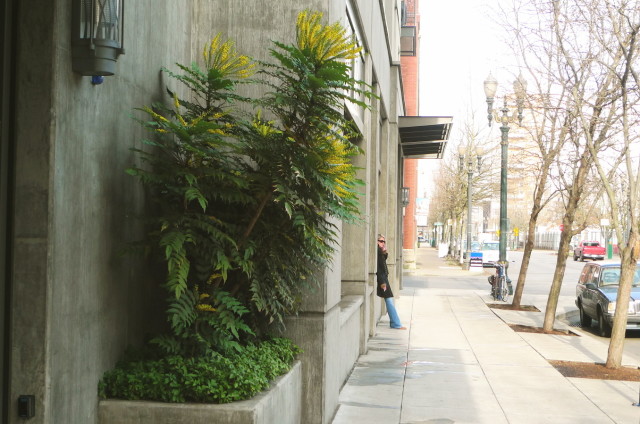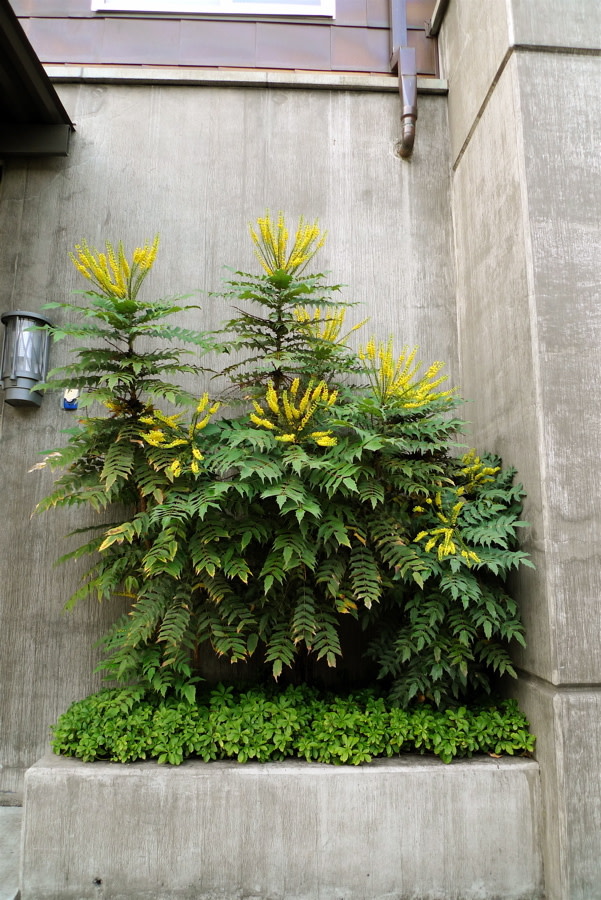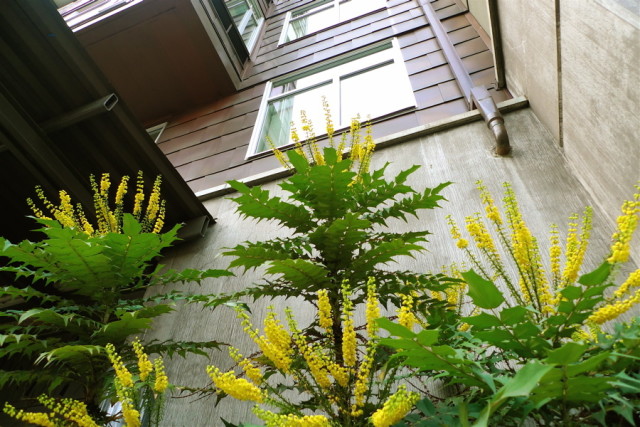Mahonia Mania!

For several years now, I’ve been admiring a pretty streetside planting in the Pearl District, on NW 9th Avenue between Hoyt and Irving. Finally, I managed to stop and admire it up close. What caught my eye? On either side of a condo garage entrance are two concrete planters with large Asian Mahonia in them. Although there are many cultivars on the market, this planting looks a lot like one of my favorites: Mahonia x media ‘Winter Sun’, an especially lovely cultivar with finer foliage and golden yellow flowers in December, January and February. You can see this dazzling planting from a block away!
Want to provide fodder for hungry hummingbirds in winter? There’s no more reliable genus than Mahonia. Included in the Mahonia brotherhood is our own native Oregon grape-holly (Mahonia aquifolium) – Oregon’s state flower – whose fat clusters of golden yellow flowers light up the Douglas fir woodland understory and brushy areas in March and April. Our native tall Oregon grape holly is in fact a gorgeous shrub, if prickly, and in shady conditions, can reach over 15 feet tall. The Pacific Northwest is home to several Mahonia including low or Cascade Oregon grape (M. nervosa ) and creeping Oregon grape (M. repens ). And starting in southern Oregon and California, Mahonia species multiply exponentially, with many interesting and drought-tolerant species populating the Southwest and Mexico.

The golden flowers look great against the gray concrete. But so does the glossy, architectural foliage and the fruit that starts to turn from green to a powder-coated blueberry-blue in late summer. Asian mahonia is an all-around brilliant urban plant.
But it’s the hardy Asian Mahonia hybrids that really put out the goods for our local hummingbirds in winter, at exactly the time when there isn’t much else in the way of nectar-rich food around Portland. That in itself would be reason enough to plant them. But it doesn’t hurt that these plants are drop-dead gorgeous, architectural plants with striking foliage, sunny yellow, candelabra-like sprays of waxy flowers and interesting greenish-blue fruit that turns vivid powdery blue, then black, before the birds devour it in springtime. Mahonia also show a surprising level of adaptability to tough conditions including low water, not-so-great soil and shade or sun. (In sun, it’s best to provide moderate supplemental summer water.)
Mahonias are evergreen shrubs in the barberry family. There are some 70 species throughout the American Southwest, Mexico and Asia. Many of the southern American species have gorgeous green to powdery-blue, prickly foliage, as well as being drought-, sun- and poor soil-tolerant. The Asian species, originating in cooler regions with richer soil, have the boldest foliage and huge sprays of flowers. Nevertheless, it’s surprising how tolerant even the Asian mahonias are of minimal water, once established.

I stood under it, trying unsuccessfully to photograph the brilliant pink-throated Anna’s hummingbird that was busily feeding on the nectar-rich flowers. Hot pink and yellow – wow!
Mahonia x media are hybrids between M. japonica and M. lomariifolia. All offer gardeners artful spikes of sunny yellow, fragrant, nectar-rich flowers throughout the winter. Depending on the cultivar, plants range from about 8-12 feet, and sometimes even taller. Their corky trunks are beautiful, should you decide to prune the foliage up off the trunks. Left to their own devices, the shrubs naturally form a vase shape.
Mahonia x media ‘Charity’ – one of the easiest to find in the Portland area these days, this excellent hybrid has chunkier foliage than most other forms. Buds color up in late November and flowering occurs December to February. 12-15’ tall and a bit less wide.
Mahonia x media ‘Arthur Menzies’ – a wonderful cultivar flowering late Dec or January through February. Reaches 10-12’ tall and nearly as wide.
Mahonia x media ‘Winter Sun’ – has fine, more delicate foliage than Charity and Arthur Menzies, with reddish-burgundy new growth in spring. Flowering starts in December most years and lasts through February. Plant reaches about 10’ tall and a bit less wide.
Have room for a few additional Mahonia species? Take this Mahonia madness a step further and extend the winter nectar supply for our little feathered friends: plant October/November-flowering Mahonia eurybracteata and the March-blooming native Mahonia aquifolium for about six months of nectar! You may start to be referred to as "That Crazy Mahonia Person"… but there are worse epithets!
Where to Buy Mahonia:
For a summary of sources for a dozen or more species and cultivars, see Plant Lust or just contact the following vendors directly:
Cistus Design Nursery
Dancing Oaks Nursery
Far Reaches Farm
Gossler Farms Nursery
Greer Gardens
